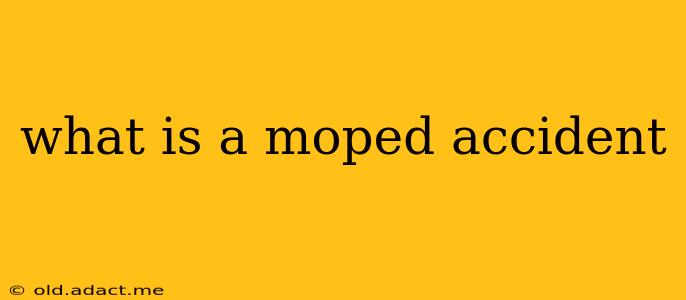What is a Moped Accident?
A moped accident is any incident involving a moped and resulting in injury, damage, or other negative consequences. This can range from a minor fender bender to a catastrophic collision resulting in serious injuries or fatalities. Mopeds, being smaller and lighter than cars or motorcycles, are often more vulnerable in accidents. Understanding the different types of moped accidents and the factors contributing to them is crucial for rider safety and accident prevention.
What are the common causes of moped accidents?
Several factors contribute to moped accidents. These can broadly be categorized as driver error, environmental factors, and vehicle malfunctions.
- Driver Error: This is the most common cause, encompassing a wide range of behaviors. These include:
- Distracted driving: Using a cell phone, eating, or adjusting music while riding.
- Speeding: Exceeding the speed limit or riding too fast for conditions.
- Failure to yield: Not yielding the right-of-way to other vehicles or pedestrians.
- Improper lane changes: Changing lanes without signaling or checking for other traffic.
- Riding under the influence of drugs or alcohol: Impairment significantly reduces reaction time and judgment.
- Lack of experience or training: Inexperienced riders may lack the skills to handle unexpected situations.
- Environmental Factors: Poor weather conditions such as rain, snow, or ice can reduce traction and visibility, increasing the risk of accidents. Poor road conditions, like potholes or debris, can also contribute. Low light conditions, particularly at night, also pose a significant hazard.
- Vehicle Malfunctions: Mechanical failures, such as brake failure or tire blowouts, can unexpectedly lead to accidents. Poorly maintained mopeds are more prone to these types of issues.
What types of injuries can occur in moped accidents?
The injuries sustained in moped accidents vary greatly depending on the severity of the impact and whether the rider was wearing protective gear. Common injuries include:
- Head injuries: Head injuries are particularly common and can range from concussions to traumatic brain injuries, which can have long-term or even life-altering consequences.
- Fractures: Broken bones, especially in the arms, legs, and collarbone, are frequent.
- Road rash: This involves abrasions and lacerations to the skin caused by contact with the road surface.
- Internal injuries: Internal bleeding and organ damage are also possible, often requiring extensive medical treatment.
- Spinal cord injuries: These can lead to paralysis and other significant disabilities.
What should I do if I'm involved in a moped accident?
Following a moped accident, your safety and the well-being of others involved is paramount. Here’s what you should do:
- Ensure safety: If possible, move the moped to a safe location away from traffic.
- Check for injuries: Assess your injuries and the injuries of others involved.
- Call emergency services: Call 911 or your local emergency number immediately if anyone is injured.
- Document the scene: Take photos or videos of the accident scene, including any damage to the vehicles and the surrounding area. Note down the license plate numbers of other vehicles involved.
- Gather information: Exchange information with other drivers and witnesses, including names, contact information, and insurance details.
- Report the accident: Report the accident to the police. Obtain a copy of the accident report.
- Seek medical attention: Even if you feel fine, seek medical attention to rule out any hidden injuries.
- Contact your insurance company: Report the accident to your insurance company as soon as possible.
Are mopeds safer than motorcycles?
While mopeds are generally smaller and slower than motorcycles, they are not inherently safer. The lack of significant protective features and their vulnerability to larger vehicles make them susceptible to serious injury in collisions. Safety depends heavily on the rider's skill, awareness, and adherence to traffic laws.
Understanding the risks associated with moped accidents and taking proactive steps to minimize these risks is essential for ensuring your safety and the safety of others on the road. Remember, always wear a helmet and protective gear, obey traffic laws, and ride defensively.
